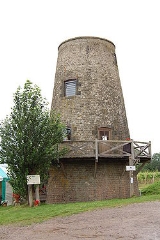
Nutbourne Windmill
Encyclopedia
Nutbourne Windmill is a tower mill
at Nutbourne
, Sussex
, England
which has been converted to retail use.
s.
and is thought to have had four Spring sails
. The mill drove two pairs of underdrift millstone
s.
Tower mill
A tower mill is a type of windmill which consists of a brick or stone tower, on top of which sits a roof or cap which can be turned to bring the sails into the wind....
at Nutbourne
Nutbourne, Horsham
Nutbourne is a hamlet running north-south situated east of Pulborough in the Horsham District of West Sussex and is in Pulborough civil parish. The topographical features of the locality consist of gently sloping terrain of the Hythe Beds with a southerly aspect and a soil of loam on greensand...
, Sussex
Sussex
Sussex , from the Old English Sūþsēaxe , is an historic county in South East England corresponding roughly in area to the ancient Kingdom of Sussex. It is bounded on the north by Surrey, east by Kent, south by the English Channel, and west by Hampshire, and is divided for local government into West...
, England
England
England is a country that is part of the United Kingdom. It shares land borders with Scotland to the north and Wales to the west; the Irish Sea is to the north west, the Celtic Sea to the south west, with the North Sea to the east and the English Channel to the south separating it from continental...
which has been converted to retail use.
History
Nutbourne Windmill was built in 1854. It had a short working life, stopping c.1894. The mill gradually became derelict, although the cap was still on the mill during the Second World War. At some point, the tail beam failed, and the windshaft was left hanging down vertically at the top of the tower, supported by the stocks alone. The mill tower now serves as a tasting room and shop for Nutbourne vineyardVineyard
A vineyard is a plantation of grape-bearing vines, grown mainly for winemaking, but also raisins, table grapes and non-alcoholic grape juice...
s.
Description
Nutbourne Windmill is a five storey brick and stone tower mill with a stage at first floor level. The mill had a beehive cap, winded by a fantailWindmill fantail
A Fantail is a small windmill mounted at right angles to the sails, at the rear of the windmill, and which turns the cap automatically to bring it into the wind. The fantail was patented in 1745 by Edmund Lee, a blacksmith working at Brockmill Forge near Wigan, England, and perfected on mills...
and is thought to have had four Spring sails
Windmill sail
Windmills are powered by their sails. Sails are found in different designs, from primitive common sails to the advanced patent sails.-Jib sails:...
. The mill drove two pairs of underdrift millstone
Millstone
Millstones or mill stones are used in windmills and watermills, including tide mills, for grinding wheat or other grains.The type of stone most suitable for making millstones is a siliceous rock called burrstone , an open-textured, porous but tough, fine-grained sandstone, or a silicified,...
s.
External links
- Windmill World Page on Nutbourne windmill.

